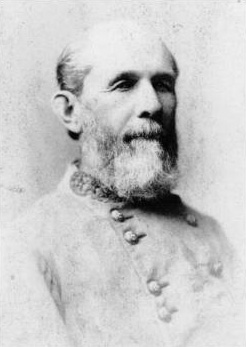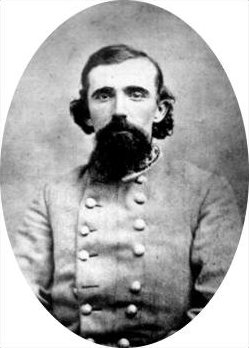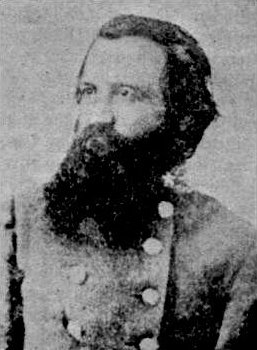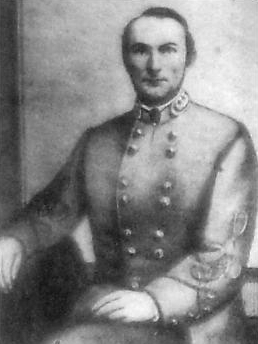
The Battle of Chickamauga, fought on September 18–20, 1863, between the United States Army and Confederate forces in the American Civil War, marked the end of a U.S. Army offensive, the Chickamauga Campaign, in southeastern Tennessee and northwestern Georgia. It was the first major battle of the war fought in Georgia and the most significant US defeat in the Western Theater, and it involved the second-highest number of casualties after the Battle of Gettysburg.

Daniel Chevilette Govan was an American miner, planter, and soldier. He served as a Confederate general during the American Civil War, prominent in campaigns and battles in the Western Theater.

The Battle of Missionary Ridge, also known as the Battle of Chattanooga, was fought on November 25, 1863, as part of the Chattanooga campaign of the American Civil War. Following the Union victory in the Battle of Lookout Mountain on November 24, Union forces in the Military Division of the Mississippi under Maj. Gen. Ulysses S. Grant assaulted Missionary Ridge and defeated the Confederate Army of Tennessee, commanded by Gen. Braxton Bragg, forcing it to retreat to Georgia.

The Tullahoma campaign was a military operation conducted from June 24 to July 3, 1863, by the Union Army of the Cumberland under Maj. Gen. William Rosecrans, and is regarded as one of the most brilliant maneuvers of the American Civil War. Its effect was to drive the Confederates out of Middle Tennessee and to threaten the strategic city of Chattanooga.

William Tatum Wofford was an American military officer who saw action in the Mexican–American War and later served as a general in the Confederate States Army during the American Civil War.

John Bratton was a U.S. Representative from South Carolina, as well as a general in the Confederate States Army during the American Civil War. He rose from private to brigadier general and led a regiment and brigade in the Army of Northern Virginia in several important battles in both the Eastern Theater and Western Theater during the war.

Hiram Bronson Granbury was a lawyer and county judge in Texas before the American Civil War. He organized a volunteer company for the Confederate States Army after the outbreak of the Civil War and became its captain. He rose to the grade of brigadier general in the Confederate army. Granbury was one of the six Confederate generals killed at the Battle of Franklin on November 30, 1864.

Thomas Benton Smith was a brigadier general in the Confederate States Army during the American Civil War.

Brigadier-General Lucius Eugene Polk was a senior officer of the Confederate States Army who commanded infantry in the Western Theater of the American Civil War. He was a nephew of Leonidas Polk.

John Herbert Kelly was, at the time of his promotion, the youngest brigadier general in the Confederate States Army. He became one of the youngest generals to die during the American Civil War, at the age of 24. His death occurred during an engagement at Franklin, Tennessee, on September 2, 1864, during Major General Joseph Wheeler's raid into Tennessee in August and early September 1864 in an attempt to destroy the railroad that Union Army Major General William Tecumseh Sherman was using to supply his force from Chattanooga, Tennessee, during the Atlanta Campaign.

James Argyle Smith was a United States Army officer, and a graduate of West Point. He is known for being a Confederate brigadier general during the Civil War, his works in the educational system in Mississippi, and in the Bureau of Indian Affairs.

Alfred Jefferson Vaughan Jr. was an American civil engineer, planter, soldier, and writer. He served as a Confederate general during the American Civil War, in which he was wounded twice, and fought mainly in the Western Theater of the conflict.

Robert Charles Tyler was a Confederate Brigadier General during the American Civil War. He was the last general killed in the conflict.
The following units and commanders fought in the Chattanooga–Ringgold campaign of the American Civil War on the Union side. The Confederate order of battle is shown separately. Order of battle compiled from the army organization during the campaign, the casualty returns and the reports.

Benjamin Jefferson Hill was a Confederate States Army brigadier general during the American Civil War. Before the war, he was a merchant and served in the Tennessee Senate. After the war, he was a merchant, lawyer and president of the McMinnville and Manchester Railroad.
The 33rd Alabama Infantry Regiment was an infantry unit from Alabama that served in the Confederate States Army during the U.S. Civil War. Recruited from the southeastern counties of Butler, Dale, Coffee, Covington, Russell and Montgomery, it saw extensive service with the Confederate Army of Tennessee before being nearly annihilated at the Battle of Franklin in 1864. Survivors from the regiment continued to serve until the final capitulation of General Joseph Johnston in North Carolina in 1865.

The 1st Florida Infantry Regiment was an infantry regiment raised by the Confederate state of Florida during the American Civil War. Raised for 12 months of service its remaining veterans served in the 1st (McDonell's) Battalion, Florida Infantry from April 1862 on. In August the depleted battalion was consolidated with the 3rd (Miller's) Battalion into the reorganized 1st Florida Infantry Regiment again. In December 1862 it merged with the 3rd Florida Infantry Regiment and received the form it kept till the war's end as the 1st and 3rd Consolidated Florida Infantry Regiment. Fighting as part of the Army of Tennessee in the Western Theater of the American Civil War it was surrendered on April 26, 1865.

The 7th Texas Infantry Regiment was a unit of Confederate States Army infantry volunteers organized in 1861 that fought mostly in the Army of Tennessee during the American Civil War. The regiment was captured at Fort Donelson in 1862 and sent to Northern prison camps. After the survivors were exchanged and new recruits added, the regiment was reconstituted and fought at Raymond, Jackson, Chickamauga, Missionary Ridge, and Ringgold Gap in 1863. The unit served in the Atlanta Campaign and at Franklin, Nashville, Averasborough, and Bentonville in 1864–1865. The regiment's 65 survivors surrendered to William Tecumseh Sherman's Federal forces on 26 April 1865.

The 10th Texas Infantry Regiment was a unit of Confederate States Army infantry volunteers organized in October 1861 that fought during the American Civil War. The regiment was captured in its first major action at Arkansas Post in January 1863. After being exchanged three months later, the 10th Texas was consolidated with two other regiments and assigned to Patrick Cleburne's division. Subsequently, the consolidated regiment fought at Chickamauga, Missionary Ridge, and Ringgold Gap in 1863. After becoming an independent regiment again, the 10th Texas fought in the Atlanta Campaign, and at Franklin and Nashville in 1864. After a second consolidation the troops fought at Averasborough and Bentonville in 1865. The regiment's soldiers surrendered to Federal forces on 26 April 1865.

The 15th Texas Cavalry Regiment was a unit of cavalry volunteers mustered into the Confederate States Army in March 1862 and fought during the American Civil War. In July 1862 the unit was dismounted and served the remainder of the war as infantry. The regiment was captured at Arkansas Post in January 1863. After being exchanged three months later, the much-reduced 15th Texas was consolidated with two other regiments and assigned to Patrick Cleburne's division in the Army of Tennessee. The consolidated regiment fought at Chickamauga, Missionary Ridge, and Ringgold Gap in 1863. After a re-consolidation, the regiment fought in the Atlanta Campaign, and at Franklin and Nashville in 1864. After a final consolidation the troops fought at Averasborough and Bentonville in 1865. The regiment's 43 surviving soldiers surrendered to Federal forces on 26 April 1865.


















